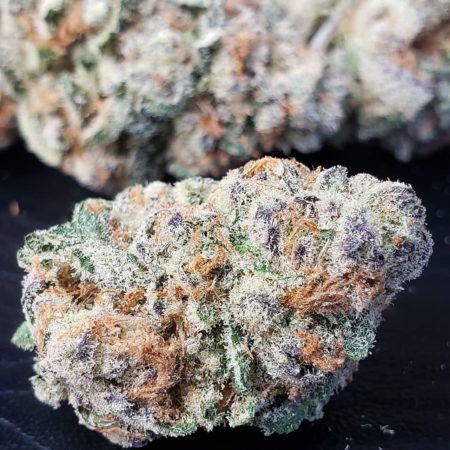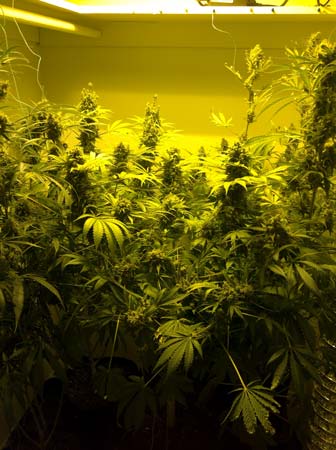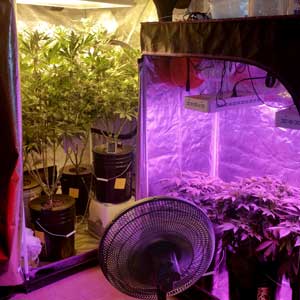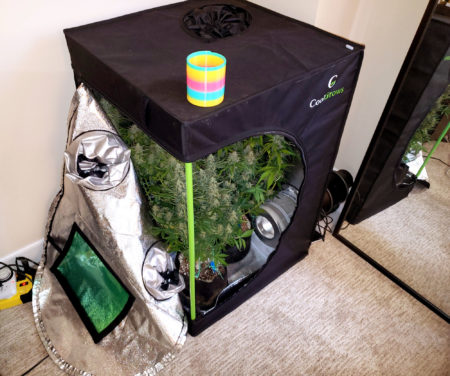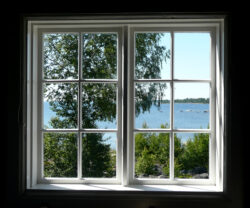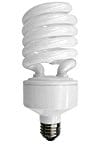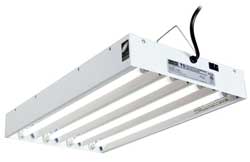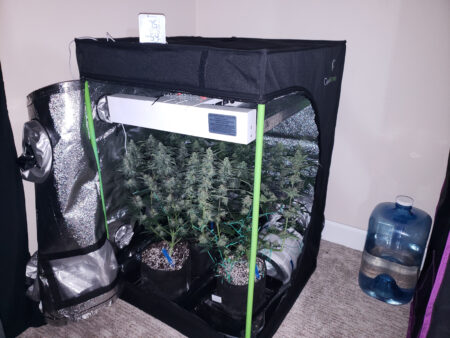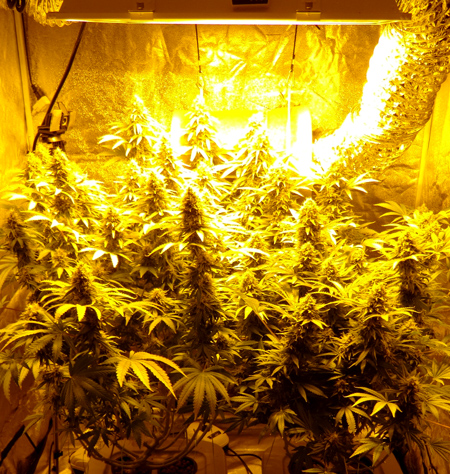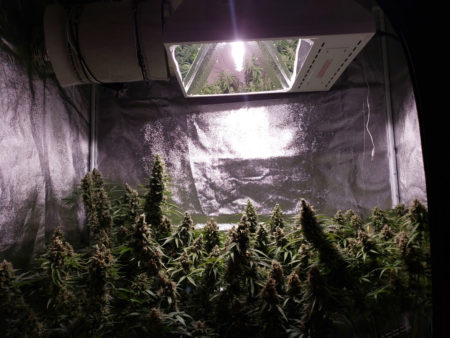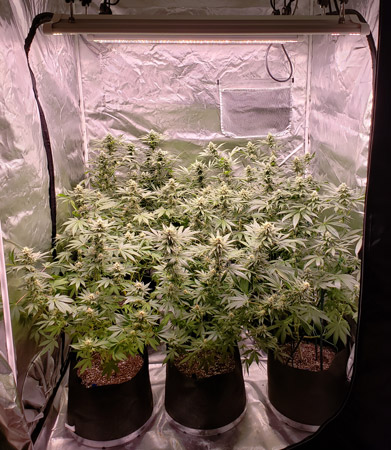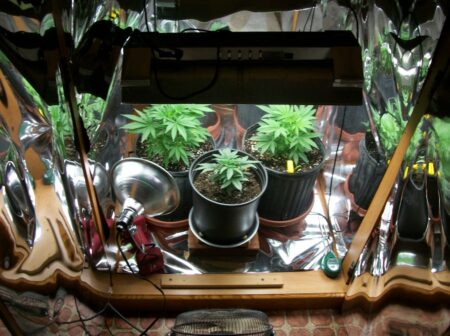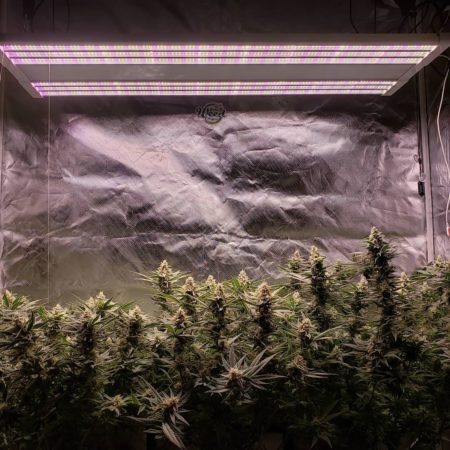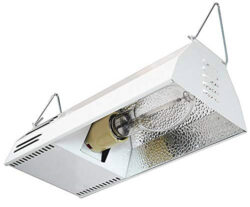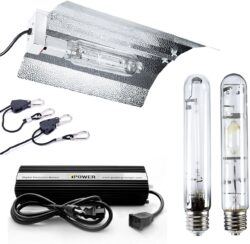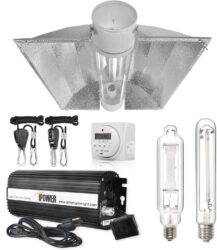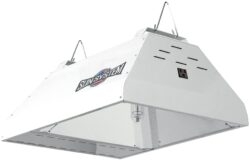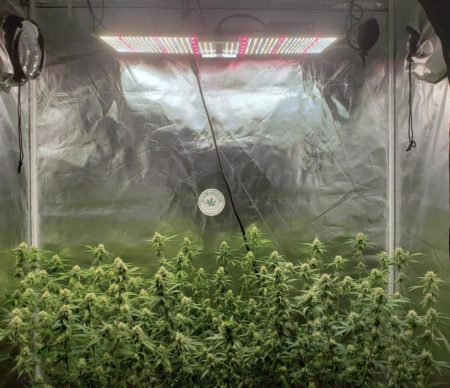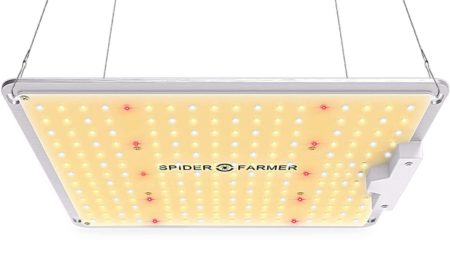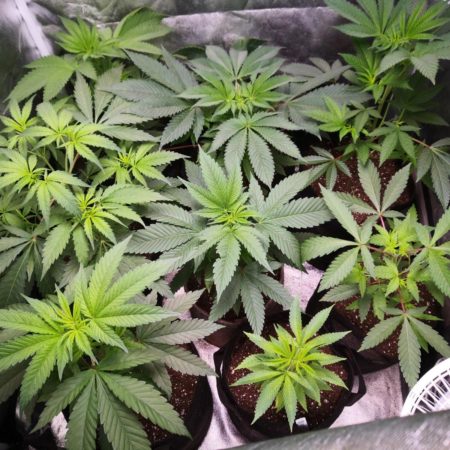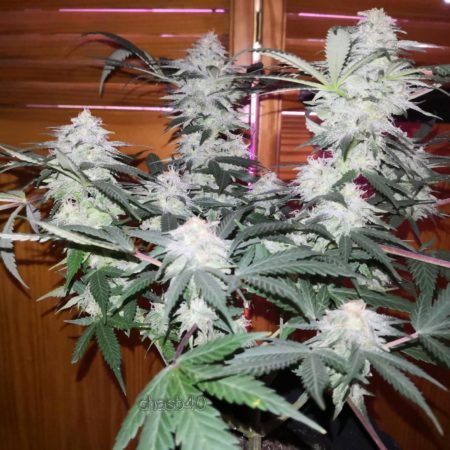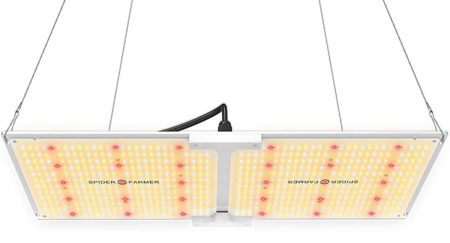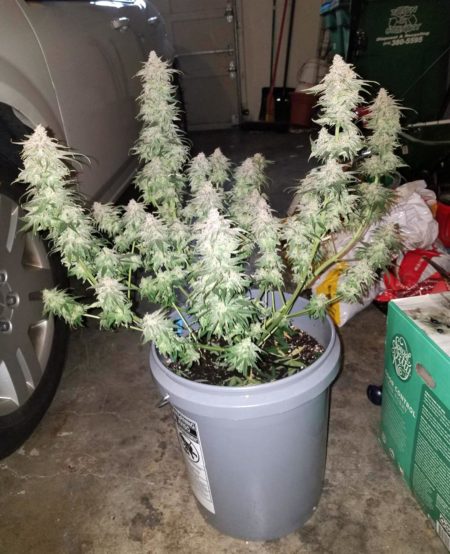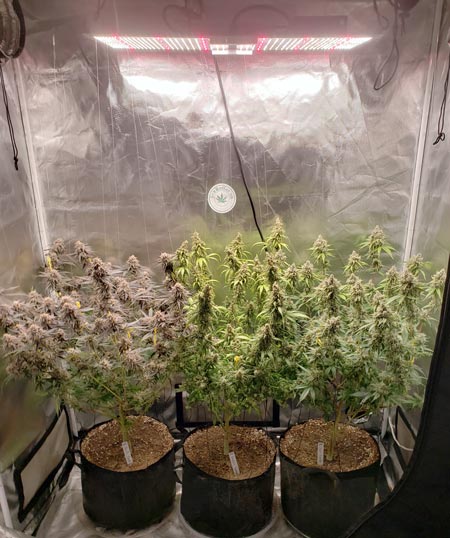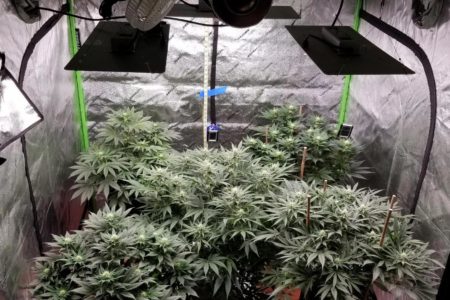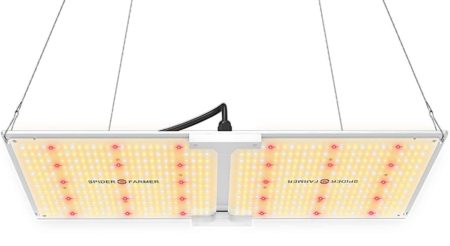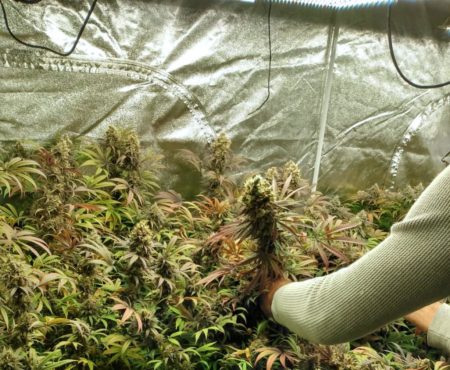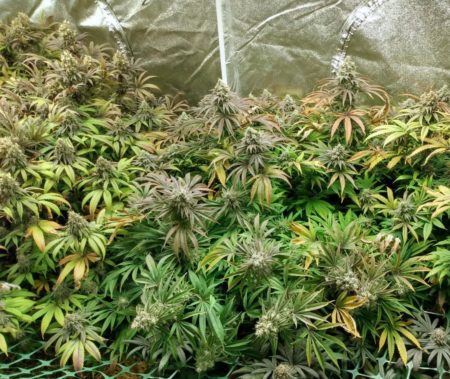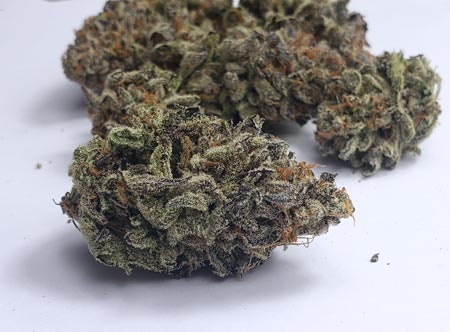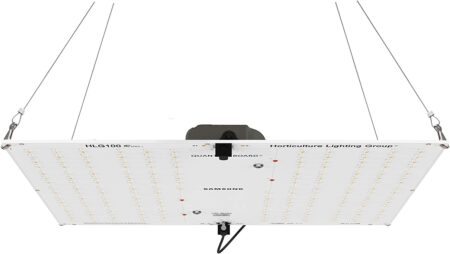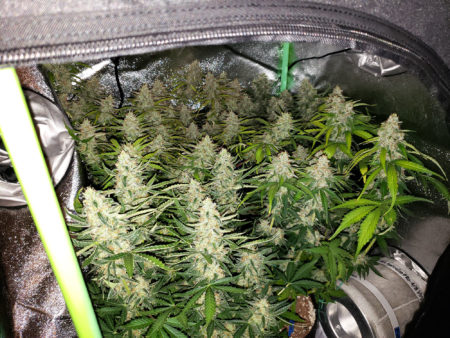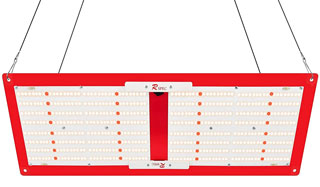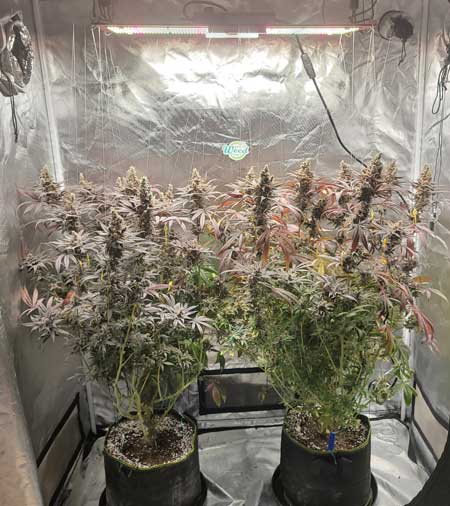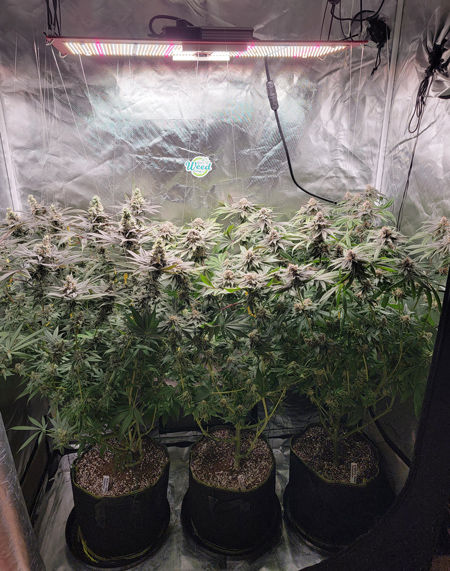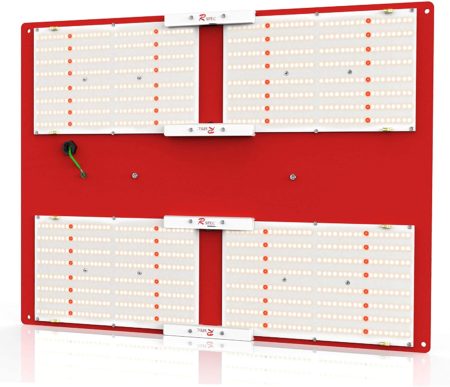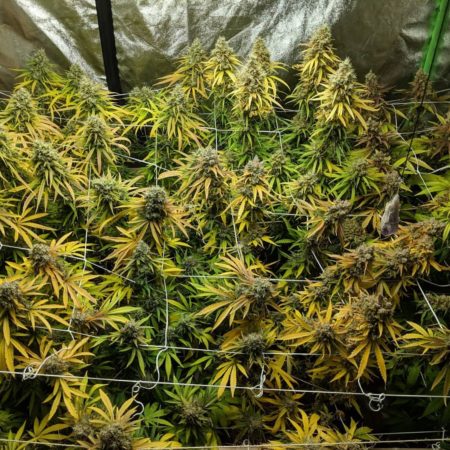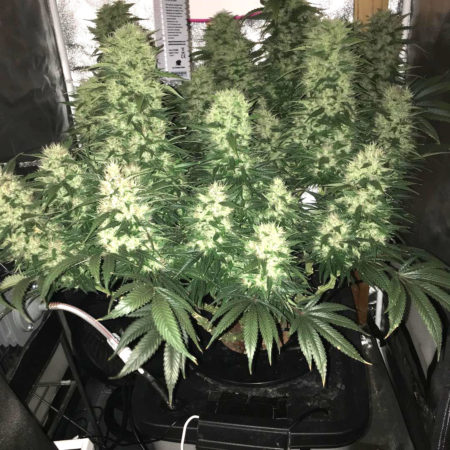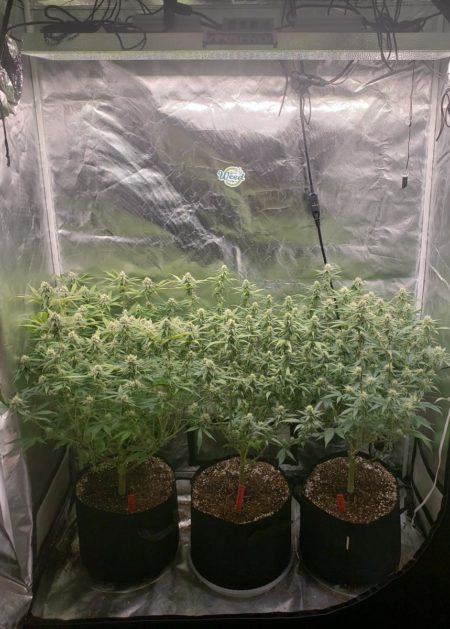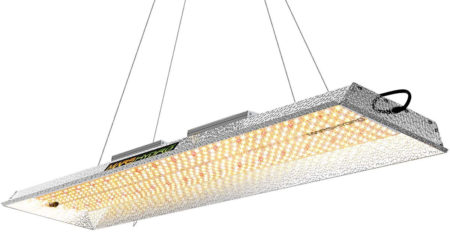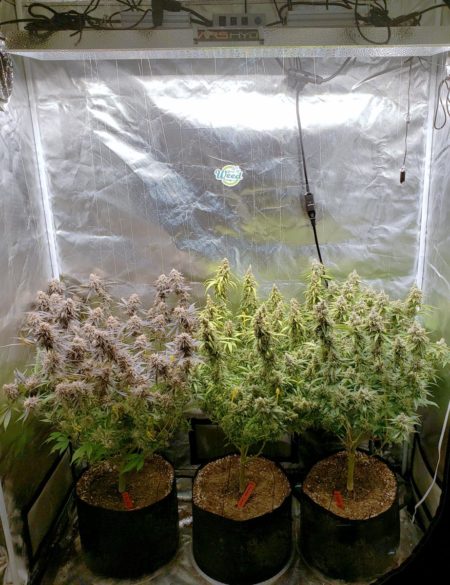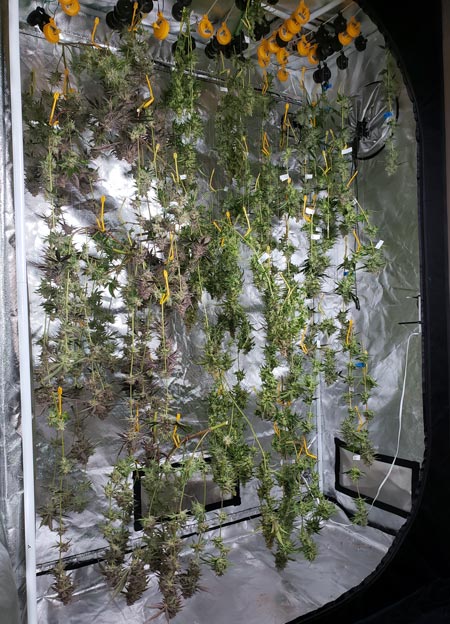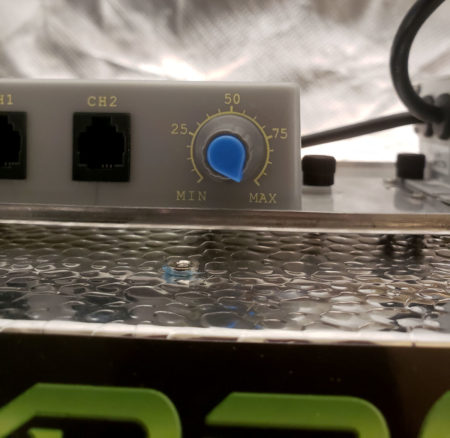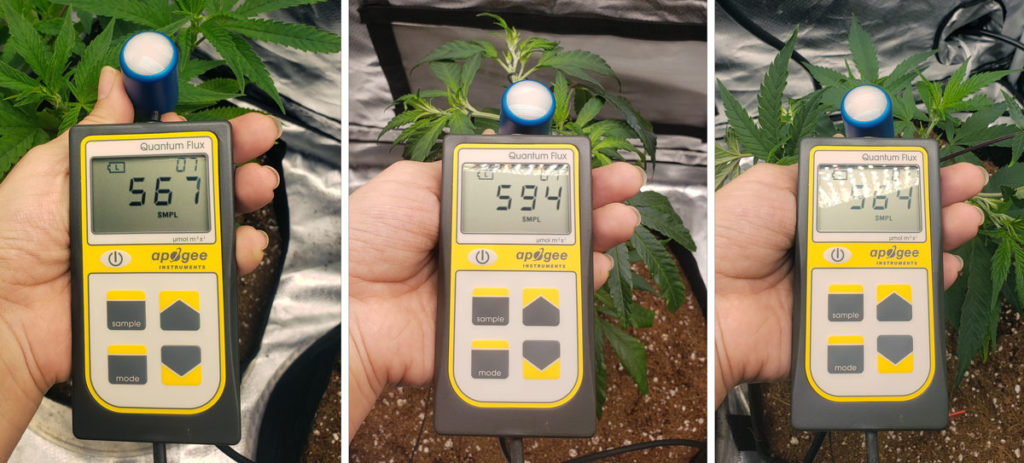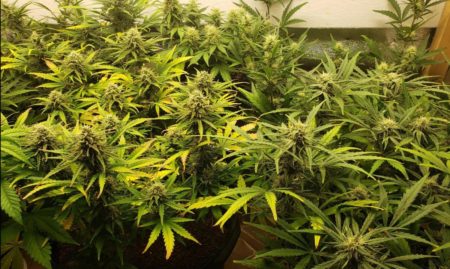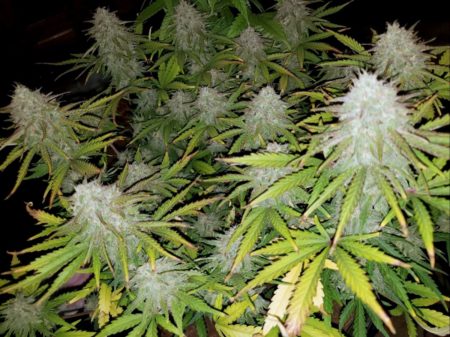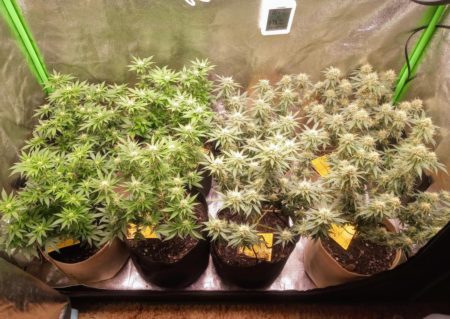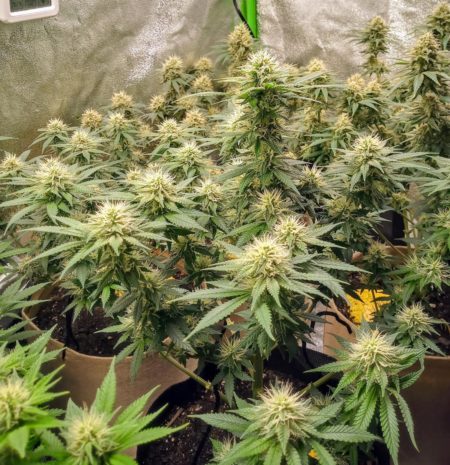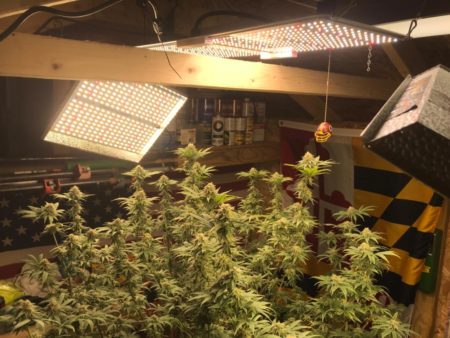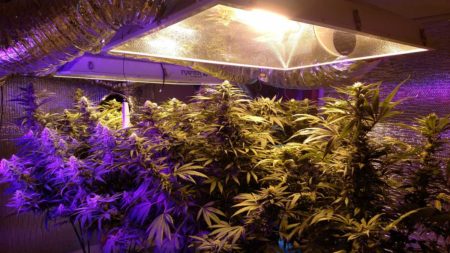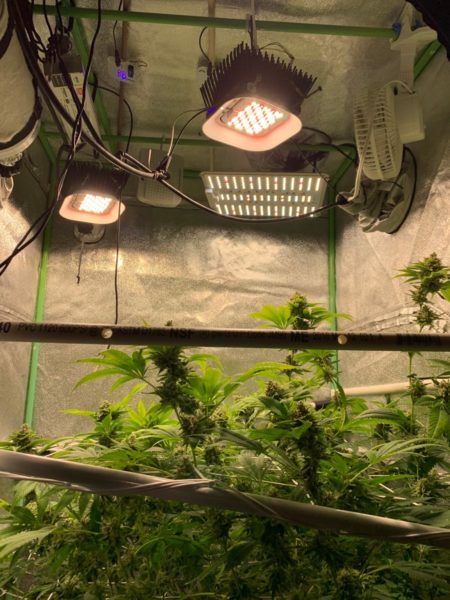by Nebula Haze
Maybe you’re still thinking about growing cannabis for the first time or perhaps you’re a marijuana growing veteran. Regardless of whether you’re a beginner grower or an expert, shopping for a new cannabis grow light is always a little overwhelming. You have hundreds if not thousands of options and variations, and each cannabis grow light has pros and cons.
Choose marijuana grow lights that produce exceptional weed so you feel proud of your buds
But what’s the current best cannabis grow light? Which is most proven when it comes to growing weed? It depends a bit on your personal grow setup so today I’ll walk you through the main options, tell you what you need to know, and share recommendations based on my own experience growing weed with just about every grow light you can use in the home grow environment.
- Step 1: Evaluate your grow space (worksheet below)
- Step 2: Identify which grow light “type” suits you
- Step 3: Pick the best grow light model for you
Grab a piece of paper, write down the answers to the questions in step 1, read step 2, then go to step 3 and find out which grow light is prescribed for you and your grow space.
Step 1: Evaluate your grow space
Need help deciding where to grow? Check out the “where to grow in the house” tutorial.
Determine how much space you have
Get a measurement like 2’x2′ (width x length) plus the height – This is important because most grow lights will have an optimal light footprint. If a light is made for a 4’x4′ in a 2’x2′ grow space, it will cook your plants.
This walk-in closet is about 4’x5′ in length x width and the height is about 7′, giving this grower a ton of space to grow whether he wants to stay small or go big.
Get a grow tent if at all possible as that will make growing weed easier for you. If you can fit at least a 4-5′ tall grow tent in your grow space, I highly recommend getting one. It gives you a sturdy way to hang your grow light, has reflective grow walls to increase light to your plants and therefore yields, is waterproof with a waterproof tray at the bottom that can capture any water that spills (so it doesn’t get on your floor and ruin carpet or wood). Lastly, a grow tent keeps dust, pet hair, spiders, and various other pests off your plants/buds while containing smells to an extent. If you set a grow tent up with a carbon filter and fan there will be no smells whatsoever, which is necessary if you need to keep your plants totally secret.
Many growers have to make due in smaller spaces. I was able to fit this 2’x2’x3′ grow tent in the corner of my bedroom when I didn’t have a spare room to grow in, and something this small would also easily fit inside most closets.
Many growers have a smaller space, but whatever size space you can fill it up with weed if you get the right grow light and grow plants properly.
Determine: What’s your heat and venting situation?
How hot or cold is this grow space typically? Are there people who use it (for example your bedroom) where extra heat might cause a problem? Don’t worry, there are suitable cannabis grow lights for just about any situation (some LEDs won’t raise the temperature of the room much if at all) but it’s good to know what you’re dealing with. If the grow space is often cold or drafty, grow lights that use big bulbs and produce heat may perform better. If the room temperature changes a lot throughout the year, dimmable grow lights can be a good investment because they let turn down the power in hot weather to help control heat.
In addition to natural temperature, does this space have access to fresh air like a window or open door? Or is this a closed closet with very little air? A small tight space without any air exchange will get hot from even a small grow light, but a big space or room with lots of fresh air can support a much bigger and hotter grow light.
If you have the ability to vent heat out a window (for example through a secret window exhaust port) or can afford to run an expensive AC, you gain the ability to use really big grow lights that put off a ton of heat but can grow pounds of weed.
Write it down:
Available height of grow space:
Area footprint (length x width of space):
Typical temperature during day:
- Cool – 70°F and under
- Normal – 70-75°F
- Hot – 75-80°F (might not seem hot but grow lights raise the temperature)
Closed space (like a closet with door shut): Yes/No
Window: Yes/No
AC (air conditioner): Yes/No
Step 2: Discover your grow light options
First I’ll give a quick overview of the 3 main grow light types: fluorescent bulbs, HID bulbs, and LEDs.
Fluorescent grow lights
- CFLs (twisty bulbs) – CFLs are a decent option for short or odd-shaped spaces especially if it gets cold. These twisty bulbs were popular as home cannabis grow light in the 2010s because you could buy the bulbs from the store and they grow excellent weed. However, you don’t see them much anymore because CFLs are harder to find than they used to be and LEDs produce bigger yields for less electricity and heat.
- T5 grow light – same technology as CFLs, but laid out flat with a reflector to point the light down to plants. These also get decent results growing weed but they’re underpowered for the budding stage and typically get small yields. You can produce a good amount of weed with oversized T5s but they get very hot at that size and produce poor yields per watt compared to your other options. In general, a T5 is best for seedlings and young plants only.
CFLs used to be popular stealth grow lights but when it comes to growing cannabis, modern LEDs outperform CFLs in every way (less heat/electricity, bigger yields, and better bud density/quality).
T5 grow lights are excellent for cannabis seedlings but are underpowered for older cannabis plants. Flowering cannabis under T5s results in poor yields per watt.
I grew a decent amount of weed with this T5 grow light, but the tent got really hot and buds were fluffy. A small LED panel in the same tent produces more and denser bud with significantly less heat and electricity. In general, if you’re considering fluorescent grow lights for growing cannabis, you’ll almost always get better results with LEDs.
HID bulbs (High intensity discharge lights i.e. The BIG bulbs)
- MH/HPS Combo – MH/HPS grow lights can take two different types of bulbs that are used at different stages of life. MH stands for metal halide and this bulb is used in the vegetative stage to keep plants short. HPS stands for high pressure sodium and you replace the MH bulb with the HPS bulb when pla ts start flowering and making buds. HPS produces significantly higher yields but typically isn’t used in the vegetative stage because it makes plants grow tall and stringy. (check out my grow journal where I used HPS from seed to harvest so you can see what I mean). Oldest cannabis grow light. HPS lights are used as street lights and back in the day some growers actually stole streetlights to grow weed with. These are super cheap to buy and produce a ton of dense weed with high bud quality. The main downside is they produce significantly more heat per watt than LEDs. A bunch of these gets hot. But they’re excellent in a cool grow room. Plants thrive in these even if it gets cold at night. I still use my 250W HPS in the winter when it gets cold and in the chill it outperforms the 300w LEDs (LEDs kick its butt in the summer though)
- LEC (also called CMH) – Just in case you’re wondering, LEC and CMH are the same type of grow light. LEC is a brand name of a CMH by the company Sun System, and the name stuck. CMH stands for Ceramic metal halide and CMH grow lights have actually been around since at least 2008 when I started growing (they used to be offered in the same wattage sizes and used a mogul socket just like MH/HPS lights back then). They’re essentially halfway between metal halide and HPS (it’s a metal halide bulb that uses ceramic like an HPS bulb). However, around 2017 CMH grow lights were rebranded and re-popularized as LECs (light emitting ceramics). They started being offered with alternative sockets and only come in proprietary 315W and 630W sizes. These are a little hotter than HPS and emit more heat per watt. They produce somewhat different results with cannabis plants compared to the MH/HPS combo. Specifically, they tend to produce a greater amount of cannabis trichomes and smells than other grow lights, especially when you use the 4k color blue bulbs, which makes them an ideal choice for growers who want weed to make extracts (especially for dabs or fresh rosin, bubble hash, or dry ice hash). Like HPS bulbs, plants grown under CMH tend to grow fast, tall, and stretchy in the vegetative stage, which can be a good or bad thing depending on what you’re looking for.
MH/HPS combo lights typically come as a kit in one of 5 sizes: 150W, 250W, 400W, 600W, 1000W. Each one is designed for a different size grow space. The most efficient size (best yields per watt) is 600W, which can yield 1-2 lb per harvest but puts off a ton of heat. When you buy MH/HPS lights they typically have a big brick-sized ballast, a reflector or hood of some sort, and the bulbs themselves. The MH bulb (fatter bulb that gives off a bluish white light) is used when plants are young to keep them short and bushy. The HPS bulb (thinner bulb that produces a garish yellow light) is switched in when plants start making buds. HPS produces some of the biggest and densest buds of any grow light, but only if you can keep it cool in the grow space.
A 600W HPS (like the one pictured here) produces a ton of weed in a small space but also makes a ton of heat.
LEC (aka CMH) lights typically come in one of two sizes: 315W, and 630W. They use the same HID technology as MH/HPS and produce just as much heat. Their ballast is usually attached directly to the reflector instead of separate. These produce incredible yields and bud quality, but they are best known for above-average terpene (smell) and trichome (sparkle) production, making them a great choice for growers looking to make extracts.
LED Grow Lights
- “Spread” style LEDs – Quantum board, scorpion style, spider style, etc. These typically have smaller diodes apread over a wide area, sometimes even with big spaces between diodes where typically plants receive too much light like the middle. These get the best yields per watt and are less likely to cook your buds than LEDs with more intense diodes.
- “Pinpoint” style LEDs – Puck LEDs, COBs, etc. with big bright diodes typically close together to almost shine a spotlight on plants. Good choice for a big room since you can easily adjust brightness in a big space. Also gets the deepest penetration so a good choice for taller plants.
- Hybrid LEDs – medium-sized panels that often use a mix of big and little LEDs. Basically somewhere in between have LEDs either very spread out or just a few big intense LEDs close together. A lot of hobby level LEDs are in this style. They give better results for short spaces than pinpoint style, but are smaller and are often less heavy per watt. Hybrids can get good results with weed, but I recommend getting a spread style LED if possible for the best cannabis yields and bud quality.
If you’re not sure which cannabis grow light to get, I recommend getting LEDs. They allow a home grower to produce a ton of high-quality weed with significantly less electricity and heat. Older LEDs produced blurple (bluish-purple) light but modern flowering LEDs typically appear pink. Vegetative LEDs typically appear white. You can use any type LED from seed to harvest though flowering LEDs result in higher yields.
Most home cannabis growers will be happiest with LED grow lights
Step 3: Choose your grow light
Finally, it all comes together! Remember the answers you wrote down earlier and I’ll show you how to pick the best marijuana grow light for your space and then I’ll help you pick the best version for each one.
Available height of grow space:
- Short spaces (under 4′ height) – Fluorescent or smaller LEDs under 200W
- Medium to tall spaces (5-6’+ height) – LEDs or HIDs (like MH/HPS or LEC or CMH)
Area footprint (length x width of space):
Choose a grow light that’s listed with your footprint or smaller. When in doubt, it’s always better to get a too-small grow light over a too-big grow light because it will cook your plants. But if the grow light is dimmable like most LEDs and some HIDs, you can often get away with a somewhat bigger light.
Just remember that grow lights are most electrically efficient at full power. So when possible, you want to have your light be full power most of the time, especially in the crucial budding /flowering stage.
Natural temperature of grow space (and is it more open or closed up)
Cold (or very open /drafty) space: Pick a bulb light. Fluorescent like CFLs or T5, or HIDs like MH/HPS or LECs/CMH. Small LEDs perform poorly in cold spaces. In a cold space, you want a bulb that gives off heat and raises the internal temperature of your plants. Especially HIDs produce huge yields and excellent bud quality in cooler spaces. If you’re determined to use LEDs you can make it work, but you’ll want to get bigger LEDs (over 300W if possible since they start putting off a decent amount of heat at that size). You should also take steps to prevent your plants from getting cold or they will produce slow growth and very small yields with LEDs.
Regular room temperature space: You’re not limited by the temperature of your grow environment. Plants like temperatures about the same as people or a little warmer. But whenever you have options I recommend LEDs for growing cannabis as they tend to be the most flexible for home growers.
Hot (or closed) space: LEDs. If you’re not dealing with cold, LEDs are almost always the best grow light choice. LEDs have more options than HID lights and get better bud quality and yields per watt in the heat.
If you’re not dealing with cold, LEDs are almost always the best grow light choice for marijuana plants.
Window or AC
If you’ve got the ability to either remove heat by venting out a window, or cooling a room with an AC, you have a setup that could support a big HPS (600W HPS or even multiple 600W) or multiple 300W-600W LEDs. If you’re going to grow a whole lot of weed, you’ll often get the best results with multiple grow lights over just one big one. Kind of like “spread style” for the whole grow room. You can even mix and match. I’ve seen some of the best cannabis yields and impressive results come out of growers that use a mix of big HPS and LEDs in the flowering stage.
Recommended Grow Light Models
At this point, you should have a pretty good idea of which type of grow light you’re most interested in: fluorescent, HIDs, or LEDs. If for some reason you’ve decided to go with fluorescent grow lights, read the CFL tutorial on how to pick the best number and wattage CFLs for your space, or check out the basic T5 grow light tutorial, but I recommend choosing one of the other grow light options for the best results with growing weed.
Now let’s go to some suggested models.
HIDs (“Big bulb” grow lights)
Best for cool spaces, otherwise you’re probably going to be happier with LEDs.
Note: 250W size is harder to find these days, so it’s not listed here. 1000W is an overpowered size for most growers, and not very electrically efficient. You’ll often double the weed with 2 x 600W vs a 1000W.
MH/HPS Combo
- Perfect for 2’x2’x4′ or bigger
- Good for cool space but doesn’t produce a ton of heat
- Keep 11-12″ away.
- Yield: 4-6 oz
- Grow space should be 2’x4′ or 3’x3′ and 5′ or taller (6′ is best so you’re not worried about height)
- Puts off significant heat, will raise the temperature of a room by several degrees if the heat isn’t vented out a window.
- Keep 12-14″ away.
- Yield: 12 oz to almost 1 lb
This 400W MH/HP model is only $120 and I was able to produce almost a pound when I used it in a 2’x4’x6′ grow tent with a 6″ Cloudline Infinity exhaust fan to vent the heat. Dimmable but gets very hot and I would only recommend it in a cool grow space unless you plan to cool the room.
- Grow space should be 4’x4’x6′ or bigger.
- Puts off a ton of heat.
- Must be vented out a window or use an AC in just about every circumstance.
- Yield: 1-2 lbs
A 600W HPS typically does best when the bulb is contained in a “cool tube” or hood like the one shown here, so hot air can be vented out a window with ducting. But for those who are willing to deal with the setup, a 600W produces some of the biggest yields of any grow light.
LEC or CMH
315W LEC grow light by Sun System
315W is the best size LEC in my opinion (there are only two, this and 630W). If you need more light get multiple of the 315s instead of a bigger one. The big ones seem to often cook buds while the 315 gives that perfect balance of huge yields, tons of trichomes, and intense terpene production. Read my tutorial on how to produce up to a pound with a 315 LEC grow light.
LED Grow Lights
Each manufacturer has different models that will fit just about any grow space. So for this list, I will list my 5 favorite manufacturers of LEDs (based on my grow tests so far) with some of their best models plus a breakdown of optimal grow space and what to expect for yields from each one.
Spider Farmer (Best Budget LED Grow Light)
Spider Farmer is a sleeper. If you’re not sure which grow light to get and cost is an issue, get one of these lights. They’re not perfect but are well constructed, don’t need any setup, are easy to use, fast plant growth, and get surprisingly great yields for a small amount of electricity. I was impressed with these lights even after using more expensive LED models.
A grow featuring the Spider Farmer SF-2000 (buds are amazingly fat at just day 28 of flowering)
- Price: $160
- Grow Space: Perfect for a 2’x2′ grow tent or closet
- Actual Power Consumption: 100W at full power, and can be dimmed. This light uses the least electricity on this list but still produces hefty buds.
- How Far to Keep from Plants: 18″ for the vegetative stage. 12-18″ away in the flowering stage (keep as close as 12″ away but if top leaves appear pale from light stress, move to 18″ away)
- Average Yields: 2-5 oz+ – keep in mind that the strain (genetics) and any plant training you do will make a huge difference in your final yields.
Chasb40 had this to say about the SF-1000: “Loving the light, plants are as well. Solid build and I don’t have to worry about hot temps in my tent, much cooler than the older blurple LEDs…and quieter.”
- Price: $260
- Grow Space: Perfect for a 2’x4′ grow tent or closet
- Actual Power Consumption: 200W at full power, and can be dimmed for younger plants. This light uses less electricity than any other LED on this list besides the SF-1000, but you wouldn’t be able to tell with the results you get. Its low power consumption is another reason this is a great budget grow light.
- How Far to Keep from Plants: 20-24″ for the vegetative stage. 18-24″ away in the flowering stage (keep as close as 18″ away but if top leaves appear pale from light stress, move to 24″ away)
- Average Yields: 4-10 oz+ – keep in mind that the strain (genetics) and any plant training you do will make a huge difference in your final yields.
David grew this plant with a SF-2000 and reported back, “Great lights. They don’t get very hot. Super light weight. Produce great buds. 100% recommend!”
This was just my first grow with a SF-20000. Amazing yields for just 200W! (check out the grow journal)
Janelle’s results on her first cannabis grow (three SF-2000s in a 5’x5′ grow tent)
- Price: $560
- Grow Space: Perfect for a 5’x5′ grow tent or space
- Actual Power Consumption: 450W at full power, and can be dimmed.
- Note: No front-facing dimmer. You have to unscrew the driver from the board and then you’ll see the dimmer.
- How Far to Keep from Plants: 24″ for the vegetative stage. 18-24″ away in the flowering stage (keep as close as 18″ away but if top leaves appear pale from light stress, move to 24″ away)
- Average Yields: 9-20 oz+ – keep in mind that the strain (genetics) and any plant training you do will make a huge difference in your final yields.
- Note: the SF-4000 light can get quite hot compared to the other Spider Farmer LEDs. Unless growing in a particularly cold grow space, you will probably need an exhaust fan or AC to control the heat from this light. Keep the temperature between 75-85°F (24-30°C) to get the best yields.
“Very nice little 450w lights indeed! My buddy’s little medical garden did very well and produced very high quality medicine. 1.91grams per watt, organic notill beds. Strains were, blackberry Kush, GG4, 501st OG, and a special cultivar called Pineapple Dreamwreck.” ~Robert
HLG Quantum Board (Great All-Around)
Horticulture Lighting Company (HLG) took the world by storm with its line of “quantum boards”. This style LED grow light was developed by hobbyist LED growers and HLG made it available commercially and turned it into a phenomenon. Now many grow lights have very similar form factors, but HLG models are still some of the best-performing. These lights are tested on real cannabis plants, and HLG releases an updated version on a regular basis as new technology is discovered and developed. However, companies like Spider Farmer are starting to offer “copycat” versions of HLG lights that seem to be performing just as well for less money. I’m not sure HLG will be able to hold this spot next year.
Why was HLG the Best All-Around LED grow light company on this list?
- Great yields
- Excellent bud quality/appearance
- High bud potency (in some tests, the buds grown under HLG lights produced significantly higher levels of THC than HID grow lights like LECs)
- Lightweight and easy to set up
These Mandarin Cookies buds grown under the HLG 300 measured 28.3% THC at the lab. Buds from a clone of the same plant grown under a LEC only measured 26.94% THC at the lab. We found increased potency across the board when we lab tested clones grown under HLG vs LEC grow lights. HLG LEDs seem to help maximize the potency of buds.
- Price: $155
- Grow Space: The small square shape and low heat output makes this model perfect for a 2’x2′ grow tent or in a closet.
- Actual Power Consumption: 95W (cannot be dimmed)
- How Far to Keep from Plants: 15-20″ for the vegetative stage. 12-15″ away in the flowering stage.
- Average Yields: 2-4+ ounces – keep in mind that the strain (genetics) and any plant training you do will make a huge difference in your final yields.
HLG 100 R-Spec Quantum Board – up to 4+ oz yield
Here are some plants I grew under this HLG 100 R-spec light in a mini 2’x2’x4′ grow tent.
- Price: $380
- Grow Space: The rectangular shape makes this model great for a 2’x4′ grow tent or closet.
- Actual Power Consumption: 270W at full power, and can be dimmed down to 90W for younger plants
- How Far to Keep from Plants: 20-24″ for the vegetative stage. 18-24″ away in the flowering stage.
- Average Yields: 7-11+ ounces – keep in mind that the strain (genetics) and any plant training you do will make a huge difference in your final yields. This LED model has performed better than most others I’ve tried so far.
HLG 300L R-Spec Quantum Board – produces high THC levels and up to 11+ oz yield
A recent grow under the HLG 300L R-Spec using defoliation in the flowering stage produced almost 11 oz (check out the full grow journal)
The HLG 300 R-Spec really brings out the purple for many strains!
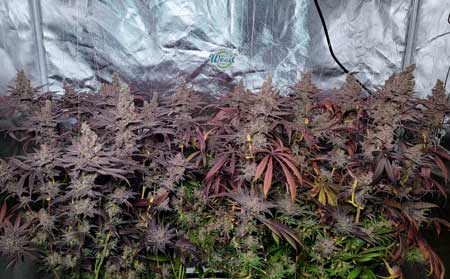
- Price: $580
- Grow Space: Ideal for a 5’x5′ grow tent
- Actual Power Consumption: 600W at full power, and can be dimmed down to 60W
- How Far to Keep from Plants: 30-36″ for the vegetative stage. 24″ away in the flowering stage (may need more distance for light-sensitive plants, or in a hot grow space).
- Average Yields: 12-21+ oz – keep in mind that the strain (genetics) and any plant training you do makes a huge difference in your final yields. Keep the temperature between 75-85°F (24-30°C) during the flowering stage to get the best yields and bud quality.
HLG 600 Quantum Board R-spec – produces high THC levels and up to 21+ oz yield
Cannabis plants grown by cannabichiro (check out their Instagram profile for more!)
Cannabis plant in DWC grown by rumplenuggrower (check out their Instagram profile for more!)
Mars Hydro (Best Coverage)
The Mars Hydro grow lights produce excellent PAR levels that are spread out evenly through the grow space. Although my plants grew slightly slower during the vegetative stage than some other LEDs, this light makes up for it in the flowering stage with massive buds. It seems engineered to excel in flowering.
Mars Hydro does pretty good in the vegetative stage but really shines in the flowering stage. These plants are only 28 days after 12/12!
- Price: $270
- Grow Space: Designed for a 2’x4′ grow tent or space
- Actual Power Consumption: 300W at full power, and can be dimmed
- How Far to Keep from Plants: 24″ for the vegetative stage. 18-24″ away in the flowering stage
- Average Yields: 7-14+ oz – keep in mind that the strain (genetics) and any plant training you do make a huge difference in your final yields.
The Mars Hydro TSL 2000W produces excellent PAR levels that are spread out evenly through the grow space.
My last Mars Hydro TSL 2000 harvest with the light kept about 24″ away (here’s the grow journal)
Here are those buds drying. I was impressed to get these results with such a low-wattage LED
Now about those PAR levels. Let me show you how well this light covers a 2’x4′ grow tent by measuring the light levels 24″ away at 100% power
Here are the results with an Apogee MQ 500 PAR meter (measured in µmol m-2 s) when measuring light levels 24″ away at each plant. The light levels stay between 564-594 µmol m-2 s at the top of every plant. That means there is barely any variation of light levels throughout the tent. This is a huge advantage over other LED models where the plants on the sides are often underdeveloped.
Here’s what grower Andres had to say about the Mars TSL 2000, “my plants came out absolutely beautiful at harvest time and I could not have been happier”
Amanda used her Mars Hydro TSL 2000 in a 2’x4′ grow tent: “The plants absolutely love it & so do I. Very bright. I like having the dimmer on it as well. Well worth the money.”
Custom LED Mix (Most Modular)
If you’ve got an unusually shaped grow space, or just want a lot of flexibility with your LED placement, sometimes the best option is to choose multiple LEDs. This is also a good way to start really small and scale up as needed.
It’s common for beginner growers to start with one small LED for their young plants, then add more lights as plants grow. For example, the grower below needed to increase his wattage overall so he added additional LEDs of a different size so he could focus a lot of light directly onto his plants.
Many growers mix and match LEDs, like Mental24 who used two Mars Hydro 1000s and one Spider Farmer SF-2000 to grow this beautiful harvest for less power and heat than a 600W HPS
Another popular option is to mix LEDs with other types of grow lights like HPS or LEC.
But if you’re a beginner and afraid to completely take the plunge into growing, start small. Get a small cheap LED like the Spider Farmer SF1000D for $90 which only uses 87 watts. It is plenty for a small plant and you could even get a plant to grow buds and produce a few ounces. If you catch the growing bug then you could start adding more expensive lights to the mix.

